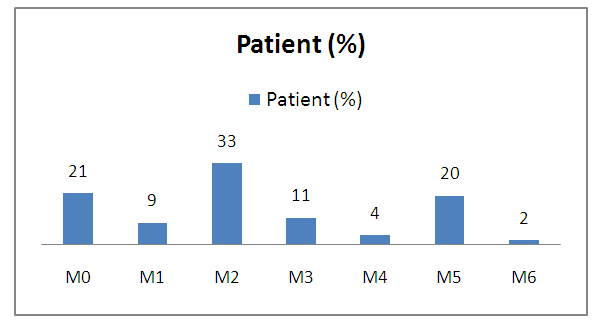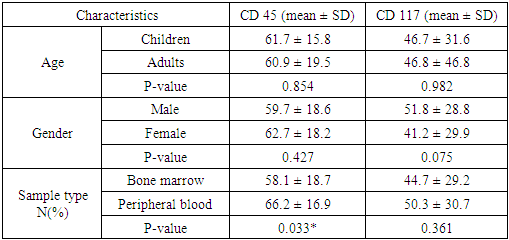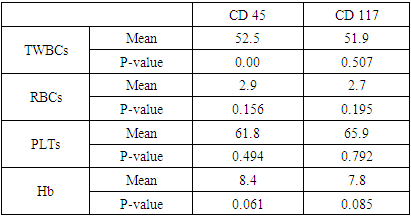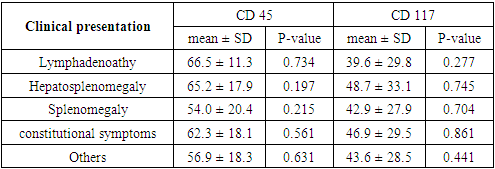-
Paper Information
- Paper Submission
-
Journal Information
- About This Journal
- Editorial Board
- Current Issue
- Archive
- Author Guidelines
- Contact Us
American Journal of Medicine and Medical Sciences
p-ISSN: 2165-901X e-ISSN: 2165-9036
2021; 11(5): 402-405
doi:10.5923/j.ajmms.20211105.09
Received: Apr. 13, 2021; Accepted: May 10, 2021; Published: May 26, 2021

Significance of the Expression of CD45 and 117 and Their Clinical Impact in Acute Myeloid Leukemia among Sudanese Patients
Amro B. E. Bashir 1, Tarig A. M. Hamid 2, Nadia M. Madani 1, Babeker Ahmed Mohammed 3
1Department of Hematology and Immunohematology, College of Medical Laboratory Science, Kararyuniversity, Khartoum, Sudan
2Department of Hematology and Immunohematology, Sharq El Nile Collage, Khartoum, Sudan
3Faculty of Medicine Department of Pathology, Kararyuniversity, Khartoum, Sudan
Correspondence to: Tarig A. M. Hamid , Department of Hematology and Immunohematology, Sharq El Nile Collage, Khartoum, Sudan.
| Email: |  |
Copyright © 2021 The Author(s). Published by Scientific & Academic Publishing.
This work is licensed under the Creative Commons Attribution International License (CC BY).
http://creativecommons.org/licenses/by/4.0/

Background: Acute myeloid leukemia is an aggressive, clonalneoplasm, with maturation arrest in granulopoiesis, resulting in an accretion of immature myeloblasts in the bone marrow. This study was prospective study conducted in Khartoum state during period from October 2018 up to January 2021. Objective: This study was aimed to determine the significance of the expression of CD45 and CD117 in Sudanese Patients with Acute Myeloid Leukemia, and their clinical impact. Method: The study population was selected as 100 AML patients as study group. 2.5 ml of venous blood were collected in (EDTA) for examination of peripheral Blood smears and complete blood count, aspirate and trephine biopsy of bone marrow were collected for smearing, staining and detected CD markers by using flowcytometry. Results: The frequency of CD45 and CD117 were (100%, 68.7% respectively). The study was reflect insignificant difference in CD45 and CD117 in correlated to age with p.value (0.854, 0.982, respectively) and also insignificant difference when correlated to gender male and female with p.value (0.427 and 0.075, respectively). The result showed that CD 45 expression was significant decreased in bone marrow sample than peripheral sample with p.value (0.033) and CD117 expression was insignificant difference between bone marrow sample and peripheral sample with p.value (0.361). Also study reflect that D45 expression in correlated to FAB classification was strongest being in M2 subtype with (P-value = 0.805) and CD117 was detected more in M3 subtype with p.value (0.04). Conclusion: the present study concluded that all AML patients had CD45, 68.7% were positive CD117 and also reflect that CD45 expression was strongest being in M2 subtype and CD117 expression was strongest being in M3 subtype.
Keywords: Acute Myeloid Leukemia, CD45, CD117, Flowcytometery, Sudan
Cite this paper: Amro B. E. Bashir , Tarig A. M. Hamid , Nadia M. Madani , Babeker Ahmed Mohammed , Significance of the Expression of CD45 and 117 and Their Clinical Impact in Acute Myeloid Leukemia among Sudanese Patients, American Journal of Medicine and Medical Sciences, Vol. 11 No. 5, 2021, pp. 402-405. doi: 10.5923/j.ajmms.20211105.09.
Article Outline
1. Introduction
- AML is the majority common leukemia in adults and continues to have the lowly survival rate of all leukemia’s (Carow et al., 1996; Linnekin, 1999; Sharawat et al., 2015). It is a heterogeneous clonal syndrome of haemopoietic progenitor cells (“blasts”) that mislay the ability to differentiate and proliferate (Malaise et al., 2009). furthermore, AML accounts for 1.1% of all novel cancer cases in the USA, has a incidence of 4.3 per 100,000 men and women per year, and account for 2.8 deaths per 100,000 menand women per year. The disease is most frequently diagnosed among group aged 65–74 years (“Cancer Stat Facts: Leukemia - Acute Myeloid Leukemia (AML),”). CD45 is a transmembrane tyrosine phosphatase ubiquitously expressed by white blood cells (WBCs). CD45 expression is high on lymphocytes and monocytes, whereas granulocytes, precursor B-cells, originator granulocytic cells, and pro-erythroblasts are also CD45 positive, but at lower levels. In compare, more mature erythroid cells are generally CD45 negative. Therefore, when combined with SSC characteristics, CD45 can help distinguish the main leukocyte (sub) populations in bone marrow (BM) (van Lochem EG et al., 2004). Most blasts have decrease CD45 expression (blast cells tend to be located in the CD45 weak positive region). However, the blast gate by CD45/SSC contains different cell types in addition to myeloidblasts. Therefore, specific markers of blast cells are required for definitive identification of blasts (usually CD34 and CD117) (Kussick SJ and Wood BL., 2003).
2. Materials and Methods
- This was prospective study done in Khartoum State in period from October 2018 to January 2021. One hundred Acute myeloid leukemia (AML) patients with high blast were involved in our study. Patients had other form of myeloproliferative disorders were excluded. 2.5 ml of Blood was collected in EDTA container. The laboratory investigations included (1) examination of peripheral Blood (PB) smears stained with Leishman's stain. (2) Examination of bone marrow (BM) aspirate smears (Leishman's) and trephine biopsy slides (H and E). (3) complete blood count by using Automated hematology analyzer Sysmex kx21. (4) Immunophenotyping by flowcytometry.Immunophenotyping: using MiltenyiBiotecMACSQuant TM flowcytometry analyzer.Software (Life Technologies, Carlsbad, CA) version 2.1.0.Phenotypic characterization of blood cells:Immunophenotyping of the leukemic blast cells was performed on PB or BM samples using MiltenyiBiotecMACSQuant TM flowcytometry analyzer equipped with MACS Quantify software version 2.4. Monoclonal antibodies (DAKO-USA) 13 labeled with Fluorescein isothicyanate (FITC) or phycoerythrin (PE) were used for immunophenotyping, the antibodies were arranged in a primary panel that was applied to all cases consisting of CDs: (CD45 and CD117).Data was analyzed by statistical package for social science (SPSS), version 16. Qualitative date was presented as mean and SD.
3. Results
- One hundred patients with Acute Myeloid Leukemia (AML) were included in our study, the mean age of patients was 38.4 ± 25.3 year old. The majority of the patients were adults (71.0%) and about (29%) patients were children. The distribution of the patients in correlated to gender (52.0%) of patients were males and (48.0%) females. The frequency of patients in associated to type of samples collected were about (63.0%) of patients sample from bone marrow and (37%) from peripheral blood. The median result of TWBCs among AML patients was increased (36.5x103/ul) ranged from 1-191x103/ul. The median result of RBCs in AML patients was decreased (3.0x1012/ul) ranged from 1-6x1012/ul. The median of platelets were decreased in patients with AML (40.0x109/L) ranged from 2-531 x109/L and the median result of haemoglobin was decreased in AML patients (8g/dl) ranged from 2-14g/dl (table 1).
|
 | Figure 1. Distribution of AML patients according to FAB subtype |
|
|
|
|
|
4. Discussion
- AML is the most common leukemia in adults, yet it continues to have the lowest survival rate (Carow et al., 1996; Linnekin, 1999; Sharawat et al., 2015). The key proliferative RTKs in AML is CD117 (Sharawat et al., 2013) and whereas the role of CD117 remains uncertain in hematopoietic neoplasia. Among our AML patients, CD45 expression was positive in 100 AML patients (100%) with median expression of CD45 was 65% ranged from 17-97. This finding similar to study reported by Basharat M et al, revealed all cases expressed CD45 with mean positivity of 70.42% ± 23.74 (Basharat M et al., 2019). The finding result showed that CD45 expression was strongest being in AML-M2 (66.9 ± 17.8) followed by AML-M5 (65.8 ± 12.9), then M1 (64.2 ± 20.2), M3 (60.9 ± 23.5), M4 (58.8 ± 16.5) and M0 (57.3 ± 21.8) and weakest in M6 (51.2 ± 4.9). CD45 was found to be statistically insignificant among all subtypes with (P-value = 0.805). This finding was disagree with study of Basharat M et al, CD45 in patients with AML was strongest being in AML-M0 and M3 (82%) followed by M1 (79%), then M2 (71.24%) and M4 (52%) and weakest in AML-M6 (29.33%). CD45 was found to be statistically insignificant among all subtypes. (Basharat M et al., 2019). In the present study the results showed that 68.7% of patients with positive CD117 with median expression was 63.3 ranged from 31-95. This finding was consistent with the results of Mortaza Raeisi et al, the CD117 was positive in 56 (84.8%) of patients with AML with median expressions was 64.5. Previously published study reported by Wells et al. CD117 expression was detected on 87% AML patients (Wells et al., 1996). The findings also showed that mean ± SD of CD117 was insignificant increased in male (51.8 ± 28.8) than female (41.2 ± 29.9) with p.value = 0.075. This finding was agreed with study of Mortaza Raeisi et al, the mean ± SD of CD117 in correlated to gender was insignificant increased in male (56.3 ± 27.7) compared to female (55.9 ± 30.0) with p.value = 0.9 (Mortaza Raeisi et al., 2019).In our study the mean result of Hb in positive CD117 AML patients was insignificant decreased (7.8 g/dl) with p.value = 0.085. The mean result of WBCs count revealed insignificant increased in TWBCs (51.9x103/μL) in positive CD117 AML patients with p.value = 0.507. The mean of platelets count in positive CD117 AML patients was insignificant decreased (65.9× 109/L) with p.value = 0.792. That agreed with published study reported by Mortaza Raeisi et al, the mean of Hb in positive CD117 AML patients was insignificant decreased (8g/dl) with p.value = 0.1, the mean of WBCs count in positive CD117 AML patients was insignificant increased (30000/mm3) with p.value = 0.5 and the mean of platelet count in positive CD117 AML patients was insignificant decreased (30000/mm3) with p.value = 0.1 (Mortaza Raeisi et al., 2019).
5. Conclusions
- This study was concluded that all AML patients had CD45, 68.7% were positive CD117 and also reflect that CD45 expression was strongest being in M2 subtype and CD117 expression was strongest being in M3 subtype.
ACKNOWLEDGEMENTS
- We gratefully acknowledge all clinicians participating in this study, We gratefully thank all staff of the flowcytometry center for their support. We would like to express our great thanks to DR; Osama Ali the general director of the flowcytometry center for their great effort.
 Abstract
Abstract Reference
Reference Full-Text PDF
Full-Text PDF Full-text HTML
Full-text HTML




